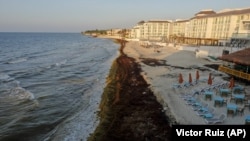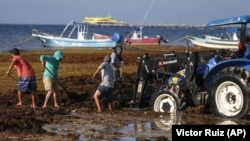Vacationers visit Mexican coastal towns like Cancun, Playa del Carmen and Tulum in search of sun, white sands and clear blue waters. But, recently, they have also experienced something unexpected: sargassum.
Sargassum is a kind of sea plant called “seaweed.” It smells bad and is generally unattractive.
Now, this seaweed is invading an area of Mexico’s Caribbean coast called the Riviera Maya. It is amassing along beaches and turning the beautiful waters brown. Experts warn that this may be the new normal.
Half of Mexico’s tourism profits come from the Riviera Maya. Very little sargassum reached it before 2014. But experts say a possible combination of climate change, pollution from fertilizers and changes in ocean currents has caused the problem to worsen.
The government of Quintana Roo, a state in Mexico, says the sargassum invasion is one of the biggest issues “that climate change has caused for the world.” It said solving the problem will require a joint effort by many countries.
When comparing March 2018 to March 2019, tourist arrivals at the Cancun airport were up 3.3 percent. But, people fear the sargassum issue will harm the tourism trade.
When sargassum dies, it leaves a terrible egg-like smell. And, as the dead seaweed drops to the ocean floor, it can kill the coral the Caribbean is known for.
Too much of the seaweed on beaches can also harm the reproductive process of sea turtles.
Jef A. Gardner travels often to Playa del Carmen from Knoxville, Tennessee. He told the Associated Press he thinks the sargassum problem is a disaster that will badly hurt tourism and the local economy.
This year, the sargassum along parts of Mexico’s coast appears worse than it was last year. And the increased growth is not just a problem for Mexico. It affects almost all countries along the Caribbean Sea on some level.
The U.S. Gulf coast also was hit with an overload of sargassum in 2014. The seaweed invaded beaches of Florida’s eastern coast in 2018. The east coast of Florida is getting hit again this year.
The seaweed is coming from Atlantic Ocean waters past the mouth of the Amazon River.
Chuanmin Hu is a professor of oceanography at South Florida University’s College of Marine Science. He says the sargassum seems to be the result of increased nutrient flows from rivers and ocean water upwelling.
Upwelling is the process of cold seawater filled with nutrients rising up from the deep. Ocean currents then carry the seaweed to the Caribbean Sea, where it can grow further.
Hu says this process is unlikely to soon stop. He says more research is needed before definitely linking it all to human activity. But, he pointed to evidence of “increased use of fertilizer and increased deforestation” as possible causes, at least for the Amazon.
For now, business owners of Mexico’s beach resorts are trying to find solutions.
“What you have to do is stop it before it even reaches the beaches,” said Adrian Lopez, the president of Quintana Roo’s employers’ federation.
But, as Lopez notes, trying to collect sargassum on water could harm some sea life, such as coral that live in shallow waters close to the coast.
Removal of sargassum after it hits beaches is also risky. It could harm the sea turtle eggs or young, for example. And masses of it usually return by the end of each day anyway, Lopez explains.
Other ideas for solutions are appearing, such as using it as an additive to make bricks. But its usefulness as a fertilizer or animal feed is limited by the chemicals it contains, like salt, iodine and arsenic.
In Quintana Roo, tourism industry workers make up almost all of the local population. Some are concerned about a federal government plan to establish a train line between coastal areas and Mayan ruins. They say the government is ignoring the seaweed problem.
“With Sargassum, there is No Mayan Train,” reads a sign launched by local businesses.
I’m Susan Shand.
And I’m Alice Bryant.
Mark Stevenson wrote this story for The Associated Press. Alice Bryant adapted it for Learning English. Caty Weaver was the editor.
_____________________________________________________________
Words in This Story
tourism – n. the activity of traveling to a place for pleasure
fertilizer – n. a substance (such as manure or a special chemical) that is added to soil to help the growth of plants
coral – n. an invertebrate sea animal that forms reefs
brick – n. a small, hard block of baked materials that is used to build structures and sometimes to make streets or paths
ruins – n. the remaining pieces of something that was destroyed, especially from ancient civilizations









